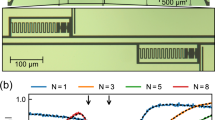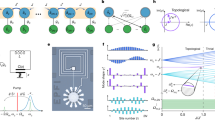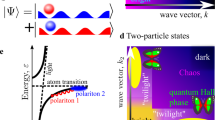Abstract
Models of light–matter interactions in quantum electrodynamics typically invoke the dipole approximation1,2, in which atoms are treated as point-like objects when compared to the wavelength of the electromagnetic modes with which they interact. However, when the ratio between the size of the atom and the mode wavelength is increased, the dipole approximation no longer holds and the atom is referred to as a ‘giant atom’2,3. So far, experimental studies with solid-state devices in the giant-atom regime have been limited to superconducting qubits that couple to short-wavelength surface acoustic waves4,5,6,7,8,9,10, probing the properties of the atom at only a single frequency. Here we use an alternative architecture that realizes a giant atom by coupling small atoms to a waveguide at multiple, but well separated, discrete locations. This system enables tunable atom–waveguide couplings with large on–off ratios3 and a coupling spectrum that can be engineered by the design of the device. We also demonstrate decoherence-free interactions between multiple giant atoms that are mediated by the quasi-continuous spectrum of modes in the waveguide—an effect that is not achievable using small atoms11. These features allow qubits in this architecture to switch between protected and emissive configurations in situ while retaining qubit–qubit interactions, opening up possibilities for high-fidelity quantum simulations and non-classical itinerant photon generation12,13.
This is a preview of subscription content, access via your institution
Access options
Access Nature and 54 other Nature Portfolio journals
Get Nature+, our best-value online-access subscription
$29.99 / 30 days
cancel any time
Subscribe to this journal
Receive 51 print issues and online access
$199.00 per year
only $3.90 per issue
Buy this article
- Purchase on Springer Link
- Instant access to full article PDF
Prices may be subject to local taxes which are calculated during checkout




Similar content being viewed by others
Data availability
The data that support the findings of this study are available from the corresponding author upon reasonable request and with the permission of the US Government sponsors who funded the work.
Code availability
The code used for the analyses is available from the corresponding author upon reasonable request and with the permission of the US Government sponsors who funded the work.
References
Walls, D. F. & Milburn, G. J. Quantum Optics 2nd edn (Springer, 2008).
Kockum, A. F. Quantum optics with giant atoms – the first five years. In International Symposium on Mathematics, Quantum Theory, and Cryptography. Mathematics for Industry Vol. 33 (eds Takagi, T. et al.) https://doi.org/10.1007/978-981-15-5191-8 (Springer, 2020).
Kockum, A. F., Delsing, P. & Johansson, G. Designing frequency-dependent relaxation rates and Lamb shifts for a giant artificial atom. Phys. Rev. A 90, 013837 (2014).
Manenti, R. et al. Circuit quantum acoustodynamics with surface acoustic waves. Nat. Commun. 8, 975 (2017).
Bolgar, A. N. et al. Quantum regime of a two-dimensional phonon cavity. Phys. Rev. Lett. 120, 223603 (2018).
Moores, B. A., Sletten, L. R., Viennot, J. J. & Lehnert, K. W. Cavity quantum acoustic device in the multimode strong coupling regime. Phys. Rev. Lett. 120, 227701 (2018).
Sletten, L. R., Moores, B. A., Viennot, J. J. & Lehnert, K. W. Resolving phonon Fock states in a multimode cavity with a double-slit qubit. Phys. Rev. X 9, 021056 (2019).
Gustafsson, M. V. et al. Propagating phonons coupled to an artificial atom. Science 346, 207–211 (2014).
Andersson, G., Ekström, M. K. & Delsing, P. Electromagnetically induced acoustic transparency with a superconducting circuit. Phys. Rev. Lett. 124, 240402 (2020).
Andersson, G., Suri, B., Guo, L., Aref, T. & Delsing, P. Non-exponential decay of a giant artificial atom. Nat. Phys. 15, 1123–1127 (2019).
Kockum, A. F., Johansson, G. & Nori, F. Decoherence-free interaction between giant atoms in waveguide quantum electrodynamics. Phys. Rev. Lett. 120, 140404 (2018).
García-Álvarez, L. et al. Fermion–fermion scattering in quantum field theory with superconducting circuits. Phys. Rev. Lett. 114, 070502 (2015).
González-Tudela, A., Paulisch, V., Chang, D. E., Kimble, H. J. & Cirac, J. I. Deterministic generation of arbitrary photonic states assisted by dissipation. Phys. Rev. Lett. 115, 163603 (2015).
Roy, D., Wilson, C. M. & Firstenberg, O. Strongly interacting photons in one-dimensional continuum. Rev. Mod. Phys. 89, 021001 (2017).
Gu, X., Kockum, A. F., Miranowicz, A., Liu, Y. & Nori, F. Microwave photonics with superconducting quantum circuits. Phys. Rep. 718–719, 1–102 (2017).
Astafiev, O. et al. Resonance fluorescence of a single artificial atom. Science 327, 840–843 (2010).
Hoi, I.-C. et al. Demonstration of a single-photon router in the microwave regime. Phys. Rev. Lett. 107, 073601 (2011).
Hoi, I.-C. et al. Microwave quantum optics with an artificial atom in one-dimensional open space. New J. Phys. 15, 025011 (2013).
Hoi, I.-C. et al. Probing the quantum vacuum with an artificial atom in front of a mirror. Nat. Phys. 11, 1045–1049 (2015).
Wen, P. Y. et al. Large collective Lamb shift of two distant superconducting artificial atoms. Phys. Rev. Lett. 123, 233602 (2019).
Dicke, R. H. Coherence in spontaneous radiation processes. Phys. Rev. 93, 99–110 (1954).
van Loo, A. F. et al. Photon-mediated interactions between distant artificial atoms. Science 342, 1494–1496 (2013).
Mirhosseini, M. et al. Cavity quantum electrodynamics with atom-like mirrors. Nature 569, 692–697 (2019).
Lalumière, K. et al. Input–output theory for waveguide QED with an ensemble of inhomogeneous atoms. Phys. Rev. A 88, 043806 (2013).
Vadiraj, A. M. et al. Engineering the level structure of a giant artificial atom in waveguide quantum electrodynamics. Preprint at https://arxiv.org/abs/2003.14167 (2020).
Lamata, L., Parra-Rodriguez, A., Sanz, M., & Solano, E. Digital–analog quantum simulations with superconducting circuits. Adv. Phys. X 3, 1457981 (2018).
Forn-Díaz, P. et al. On-demand microwave generator of shaped single photons. Phys. Rev. Appl. 8, 054015 (2017).
Kimble, H. J. The quantum internet. Nature 453, 1023–1030 (2008).
O’Brien, J. L., Furusawa, A. & Vuckovic, J. Photonic quantum technologies. Nat. Photon. 3, 687–695 (2009).
Koch, J. et al. Charge-insensitive qubit design derived from the Cooper pair box. Phys. Rev. A 76, 042319 (2007).
Blais, A., Huang, R.-S., Wallraff, A., Girvin, S. M. & Schoelkopf, R. J. Cavity quantum electrodynamics for superconducting electrical circuits: an architecture for quantum computation. Phys. Rev. A 69, 062320 (2004).
Macklin, C. et al. A near–quantum-limited Josephson traveling-wave parametric amplifier. Science 350, 307–310 (2015).
Lu, Y. et al. Characterizing decoherence rates of a superconducting qubit by direct microwave scattering. Preprint at https://arxiv.org/abs/1912.02124 (2019).
Kjaergaard, M. et al. Superconducting qubits: current state of play. Annu. Rev. Condens. Matter Phys. 11, 369–395 (2020).
Chow, J. M. et al. Detecting highly entangled states with a joint qubit readout. Phys. Rev. A 81, 062325 (2010).
Campbell, E. T., Terhal, B. M. & Vuillot, C. Roads towards fault-tolerant universal quantum computation. Nature 549, 172–179 (2017); correction 559, E6 (2018).
Kannan, B. et al. Generating spatially entangled itinerant photons with waveguide quantum electrodynamics. Preprint at https://arxiv.org/abs/2003.07300 (2020).
Pichler, H., Choi, S., Zoller, P. & Lukin, M. D. Universal photonic quantum computation via time-delayed feedback. Proc. Natl Acad. Sci. USA 114, 11362–11367 (2017).
Acknowledgements
We thank Y. Sung and A. Greene for valuable discussions. This research was funded in part by the US Department of Energy, Office of Science, Basic Energy Sciences, Materials Sciences and Engineering Division under contract no. DE-AC02-05-CH11231 within the High-Coherence Multilayer Superconducting Structures for Large Scale Qubit Integration and Photonic Transduction programme (QISLBNL); and by the Department of Defense via MIT Lincoln Laboratory under US Air Force contract no. FA8721-05-C-0002. B.K. acknowledges support from the National Defense Science and Engineering Graduate Fellowship programme. M.K. acknowledges support from the Carlsberg Foundation during a portion of this work. A.F.K. acknowledges support from the Swedish Research Council (grant no. 2019-03696), and from the Knut and Alice Wallenberg Foundation through the Wallenberg Centre for Quantum Technology (WACQT). F.N. acknowledges support from the Army Research Office (grant no. W911NF-18-1-0358), the Japan Science and Technology Agency (via the Q-LEAP programme, and CREST grant no. JPMJCR1676), the JSPS KAKENHI (grant no. JP20H00134), the Foundational Questions Institute, and the NTT PHI Laboratory. The views and conclusions contained herein are those of the authors and should not be interpreted as necessarily representing the official policies or endorsements of the US Government.
Author information
Authors and Affiliations
Contributions
B.K., D.L.C., A.F.K., F.N., S.G. and W.D.O. conceived and designed the experiment. B.K. and D.L.C. designed the devices. B.K. and M.J.R. conducted the measurements, and B.K., M.J.R., A.F.K., J.B. and M.K. analysed the data. D.K.K., A.M., B.M.N. and J.L.Y. performed sample fabrication. B.K. and M.J.R. wrote the manuscript. P.K., A.V. and R.W. assisted with the experimental setup. T.P.O., S.G. and W.D.O. supervised the project. All authors discussed the results and commented on the manuscript.
Corresponding authors
Ethics declarations
Competing interests
The authors declare no competing interests.
Additional information
Peer review information Nature thanks Michael Hartmann, Wolfgang Pfaff and the other, anonymous, reviewer(s) for their contribution to the peer review of this work.
Publisher’s note Springer Nature remains neutral with regard to jurisdictional claims in published maps and institutional affiliations.
Extended data figures and tables
Extended Data Fig. 1 Experimental setup.
A schematic diagram of the experimental setup used to obtain the data presented in the main text.
Extended Data Fig. 2 Device C.
a, A schematic diagram of a giant-atom device with two qubits coupled to the waveguide at three points. The ratios ϕ1/ϕ2, ϕ1/ϕ3 and ϕ2/ϕ3 are fixed in hardware. b, A false-colour optical micrograph image of the device in the configuration shown in a. Each qubit (yellow) has a readout resonator (red) and flux line (green) for independent readout and flux control. The central waveguide (blue) is terminated to 50 Ω. Airbridges are placed every 80 μm along the waveguide to tie the ground planes together and prevent slotline modes.
Rights and permissions
About this article
Cite this article
Kannan, B., Ruckriegel, M.J., Campbell, D.L. et al. Waveguide quantum electrodynamics with superconducting artificial giant atoms. Nature 583, 775–779 (2020). https://doi.org/10.1038/s41586-020-2529-9
Received:
Accepted:
Published:
Issue Date:
DOI: https://doi.org/10.1038/s41586-020-2529-9
This article is cited by
-
Photons go one way or another
Nature Physics (2023)
-
On-demand directional microwave photon emission using waveguide quantum electrodynamics
Nature Physics (2023)
-
Collective radiance of giant atoms in non-Markovian regime
Science China Physics, Mechanics & Astronomy (2023)
-
Optical multi-Fano-like phenomena with giant atom–waveguide systems
Quantum Information Processing (2023)
-
Tunable bandpass routers of single photons with three-level emitters
Quantum Information Processing (2023)
Comments
By submitting a comment you agree to abide by our Terms and Community Guidelines. If you find something abusive or that does not comply with our terms or guidelines please flag it as inappropriate.



